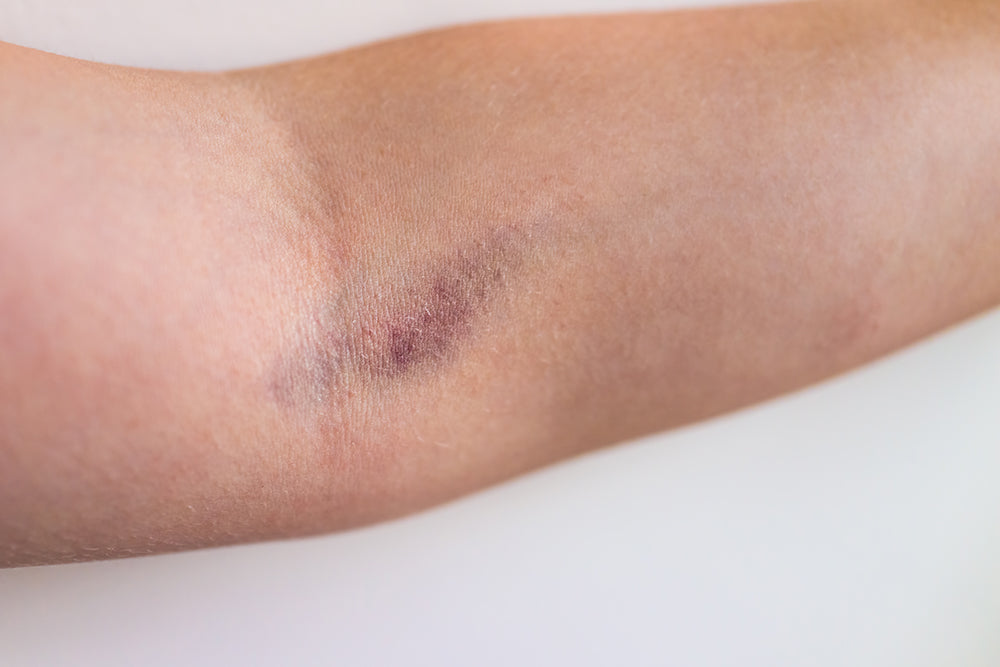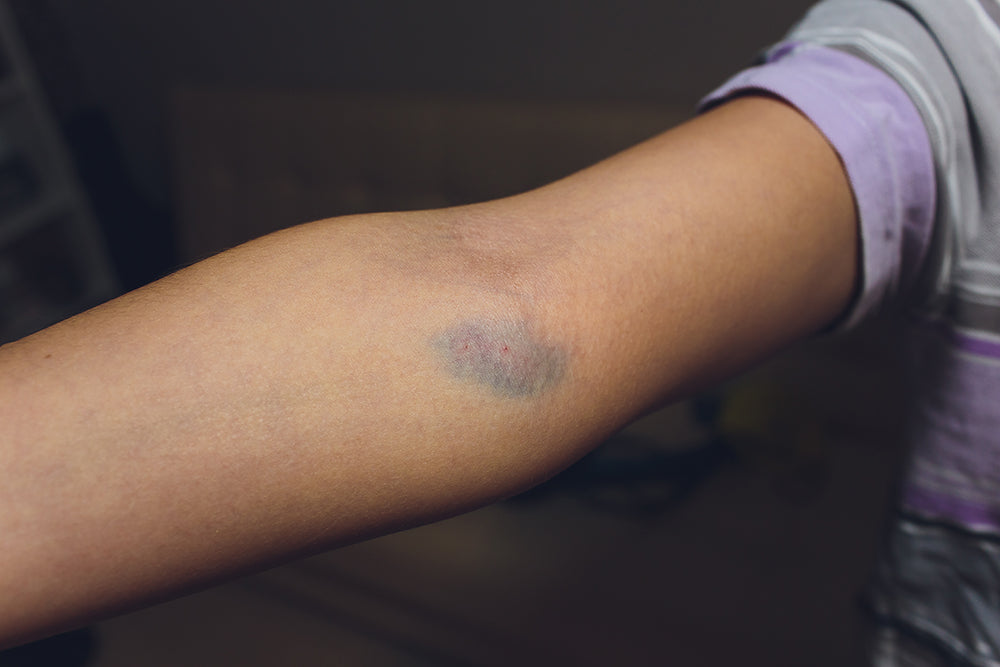When inserting an IV line, a nurse may accidentally puncture the vein with the needle, resulting in what is known as a blown vein.
This article explains the leading causes and symptoms of a blown vein and the ways in which Reset IV nurses ensure your safety during IV therapy treatment.
What Is a Blown Vein?
A vein that takes damage from a needle during an IV procedure is called a blown vein. Blown veins leak blood, causing skin to darken around the injection site.
Veins are responsible for returning blood to the heart, where it is reoxygenated and pumped back through the arteries to the rest of the body. The wall of each vein has four layers:
- The outer layer (tunica adventitia)
- The muscle layer (tunica media)
- A thin fibrous layer
- The inner layer (tunica intima)
An IV must pass through the four layers until the needle tip is in the vein’s center (lumen). Once the needle hits the inner layer, the nurse observes a “flashback” as the blood enters the needle’s flash chamber. That may not mean the needle is in the vein, so the needle must move forward about 1mm before the catheter can advance into the vein. However, if the needle goes too far, is not inserted cleanly (for instance, if the nurse “fishes” for a vein once the needle is under the skin), or moves during insertion, the punctured vein can begin to leak blood into the surrounding tissue.
Symptoms of a blown vein include:
- Bruising
- Swelling
- Hematoma
- Stinging
- Pain or discomfort

Recognizing a blown vein
Inform your nurse at once if you feel pain or stinging during the insertion process. An IV catheter insertion should feel like a quick pinch. If it hurts beyond the initial insertion, that’s an indication that something is amiss. Real pain during an insertion is not normal, so don’t try to tough it out if you’re hurting.
If your skin feels tight after insertion, let your nurse know. Tightness is another sign of blood leakage.
Is a blown vein dangerous?
A blown vein, also known as a ruptured vein, is usually harmless and doesn't cause any long-term damage. In most cases, you are likely to experience only minor discomfort that lasts a couple of days. The bruising will gradually get lighter and disappear within 10 to 12 days.
However, when a vein blows, the needle must be removed immediately. The vein should not be used for inserting an intravenous line until it heals completely. Your nurse will choose another vein to continue the procedure.
In rare cases, a blown vein may collapse. This happens when the sides of a vein become swollen and cave in toward each other, preventing blood from flowing freely. If the damage is severe, a collapsed vein can become permanent.
Another potential complication of a blown vein is infiltration, meaning the IV solution is inadvertently administered into the tissue surrounding the vein. If a significant quantity of fluid has accumulated under the skin, infiltration may cause nerve damage.
A blown vein may also lead to extravasation, that is, tissue destruction or blistering, which occurs when the medication leaking out of the vein becomes toxic. Extravasation may need to be treated with antibiotics to prevent infection. Depending on the contents of the IV therapy bag, the nurse may need to use an antidote before removing the needle in case the leaked medication has the potential to cause harmful side effects. This is not usually an issue with mobile IV therapy.
If the vein does not heal within a few weeks, seek medical attention. Contact a doctor if you have trouble moving your limb or notice any pus accompanying the tenderness or swelling.
Common Causes of Veins Blowing During IV
Several factors can cause a vein to rupture when a nurse inserts an IV catheter. Some of the most common include:
Accidentally perforating both sides of the vein
Accidental perforation is the most common cause of a blown vein. This occurs when a needle enters the vein and goes out through the other side, causing a leak. Perforating both sides of the vein may happen when:
- The needle is too large for the vein.
- The needle is inserted at the wrong angle.
- The patient has so-called rolling veins that bounce away when a nurse tries to insert a needle.
Inserting a needle into a movable vein
Some veins move around when pressure is applied to the area, which makes it more difficult to insert a needle or keep it in the vein. Rolling veins can’t be helped, but your nurse should check whether your vein moves prior to needle insertion.
Inserting a needle into a highly sensitive or fragile vein
Your vein may blow if its walls are extremely fragile or too thin to be perforated. Fragile veins are more common in elderly adults and patients who have undergone long-term IV chemotherapy or other IV use that causes scar tissue within veins.
Moving while a needle is inserted into the vein
If you move during insertion, the nurse will have a harder time placing the catheter correctly, increasing the risk of a blown vein. It’s crucial to remain as still as possible until the needle is in place.

How to Treat a Blown Vein
If a vein ruptures, your nurse will immediately turn off the IV drip and apply light pressure or an ice pack to the affected area to reduce swelling. After cleaning the site to prevent infection, the nurse will insert a new IV line into the other arm to continue your treatment.
Rest the affected arm and avoid any strenuous activity to promote healing. Apply cold packs to your arm at regular intervals to minimize swelling.
However, if you experience significant swelling, blood leak into the surrounding area, abnormal sensitivity, or a risk of infection, seek immediate medical assistance to prevent any complications.
What can I expect if I have a blown vein?
While the term “blown vein” sounds scary, keep in mind that a vein rupture is generally harmless. Your IV therapy nurse is well-trained in procedures to minimize blown vein discomfort. You may experience minor discomfort for a day or two after a blown vein, but fear of a blown vein is certainly not a reason to avoid IV therapy.
If you’ve had a blown vein, always tell your healthcare provider when undergoing any other IV therapies, either in a mobile or hospital setting.
A blown vein can only be used for IV therapy again once it’s fully healed. If used for IV therapy prior to complete healing, the vein walls are likely to swell and prevent the IV solution from getting into your bloodstream.
Ways to Prevent a Blown Vein from an IV
To minimize the risk of blowing a vein, your nurse will take the following precautions:
- Take the time to identify the best possible vein for inserting a needle. The vein should be visible, straight, and have the right size. (The nurse may ask you to make a fist if finding a good vein is difficult.)
- Stabilize the vein by placing a thumb below the puncture site.
- Choose the correct size of needle for the vein.
- Insert the needle at a 15–30-degree angle.
- Withdraw the needle slowly and carefully while applying gentle pressure to the injection site.
What you can do to avoid getting a blown vein from an IV treatment
Your IV therapy nurse will take care of everything, but there are a few small steps you can take to help avoid the hassle and potential complications of a blown vein.
- Drink plenty of water and hydrate well before your IV therapy. Drinking water boosts blood volume, which makes veins more prominent. If you’re well hydrated, the nurse should have an easier time finding a vein.
- Remain as still as you can while the nurse inserts the needle, and try not to move until the tourniquet is loosened.
- Inform the nurse in advance if your veins have blown in the past and if you have experienced any complications.
How Reset IV Nurses Avoid Blown Veins

At Reset IV, our priority is to provide IV treatments that meet the highest safety standards. Our nurses are fully licensed and insured in accordance with the strict standards in the states we operate in. With years of experience working in hospitals and clinics and over 12,000 IVs administered, they’re qualified to deliver the safest procedure possible.
Our nurses use a sterile solution of water, electrolytes, vitamins, and medications specifically developed for intravenous therapy and tailored to your needs. In addition, our top-of-the-line catheters provide blood control and help reduce the risk of blood exposure and contamination. Our needles help maximize your comfort with low penetration force in order to make your IV therapy a smooth and painless process. At Reset IV, you are in very good hands.
We offer mobile IV services in Las Vegas, Los Angeles, Miami, and numerous other locations.

